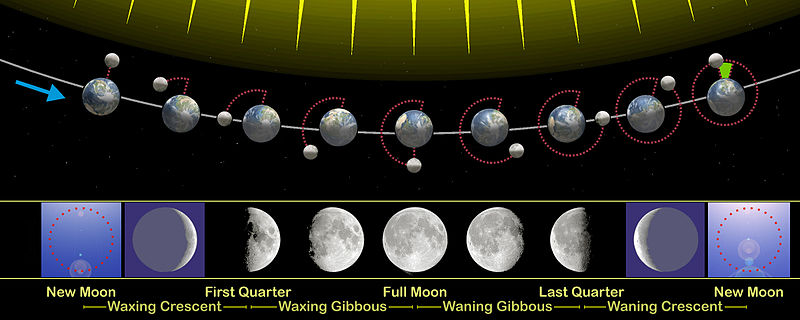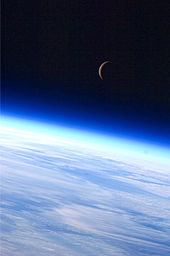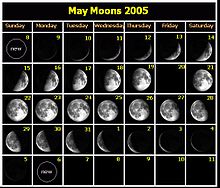Lunar phase: Difference between revisions
improve |
|||
| Line 91: | Line 91: | ||
[[File:Moon phase calendar May2005.jpg|thumb|May–June 2005 calendar of lunar phases]] |
[[File:Moon phase calendar May2005.jpg|thumb|May–June 2005 calendar of lunar phases]] |
||
{{main|Lunar calendar}} |
{{main|Lunar calendar}} |
||
The average calendrical month, which is {{frac|12}} of a year, is about 30.44 days, while the Moon's phase ([[synodic]]) cycle repeats on average every 29.53 days. Therefore the timing of the Moon's phases shifts by an average of almost one day for each successive month. Photographing the Moon's phase every day for a month, starting in the evening after sunset, and repeating approximately 25 minutes later each successive day, ending in the morning before sunrise, would create a composite image like the example calendar from May 8, 2005, to June 6, 2005. There is no picture on May 20 since a picture would be taken before midnight on May 19, and after midnight on May 21. Similarly, on a calendar listing moon rise or set times, some days will appear to be skipped. When the Moon rises just before midnight one night it will rise just after midnight the next (so too with setting). The 'skipped day' is |
The average calendrical month, which is {{frac|12}} of a year, is about 30.44 days, while the Moon's phase ([[synodic]]) cycle repeats on average every 29.53 days. Therefore the timing of the Moon's phases shifts by an average of almost one day for each successive month. Photographing the Moon's phase every day for a month, starting in the evening after sunset, and repeating approximately 25 minutes later each successive day, ending in the morning before sunrise, would create a composite image like the example calendar from May 8, 2005, to June 6, 2005. There is no picture on May 20 since a picture would be taken before midnight on May 19, and after midnight on May 21. Similarly, on a calendar listing moon rise or set times, some days will appear to be skipped. When the Moon rises just before midnight one night it will rise just after midnight the next (so too with setting). The 'skipped day' is jmoon has a predictable orbit every month |
||
== Calculating phase == |
== Calculating phase == |
||
Revision as of 17:33, 16 April 2014

The lunar phase or phase of the moon is the shape of the illuminated (sunlit) portion of the Moon as seen by an observer, usually on Earth. The lunar phases change cyclically as the Moon orbits the Earth, according to the changing relative positions of the Earth, Moon, and Sun. The half of the lunar surface facing the Sun is always sunlit, but the portion of this illuminated hemisphere that is visible to an observer on Earth can vary from about 100% (full moon) to 0% (new moon). The lunar terminator is the boundary between the illuminated and darkened hemispheres. Aside from some craters near the lunar poles such as Shoemaker, all parts of the Moon see around 14.77 days of sunlight followed by 14.77 days of "night" (the "dark side" of the Moon is a reference to radio darkness, not visible light darkness).
The principal lunar phases are new moon, first quarter moon, full moon and last quarter moon. These are the instants when, respectively, the Moon's apparent geocentric celestial longitude minus the Sun's apparent geocentric celestial longitude is 0°, 90°, 180° and 270°. Last quarter moon is also known as third quarter moon.
Names of lunar phases

In Western culture, the phases of the Moon have been given the following names, in sequential order:

| Phase | Northern Hemisphere | Southern Hemisphere | Visibility | Mid-phase
standard time |
|---|---|---|---|---|
| New moon | Not visible (too close to the Sun)
Later to be followed by the Moon's first visible crescent |
(too close to Sun) | (too close to Sun) | |
| Waxing crescent | Right side, 1–49% lit disc | Left side, 1–49% lit disc | late afternoon and
post-dusk |
3 pm |
| First quarter | Right side, 50%-lit disc | Left side, 50%-lit disc | afternoon and
early evening |
6 pm |
| Waxing gibbous | Right side, 51–99% lit disc | Left side, 51–99% lit disc | late afternoon and
most of night |
9 pm |
| Full moon | Completely illuminated disc | Sunset to sunrise
(all night) |
sunset to sunrise
(all night) | |
| Waning gibbous | Left side, 51–99% lit disc | Right side, 51–99% lit disc | most of night and early morning | 3 am |
| Last quarter | Left side, 50%-lit disc | Right side, 50%-lit disc | late night and morning | 6 am |
| Waning crescent | Left side, 49-1% lit disc
Diminishing to the Moon's last visible crescent
|
Right 1–49% lit disc | pre-dawn and morning | 9 am |
When the Sun and Moon are aligned on the same side of the Earth the Moon is "new", and the side of the Moon visible from Earth is not illuminated by the Sun. As the Moon waxes (the amount of illuminated surface as seen from Earth is increasing), the lunar phases progress from new moon, crescent moon, first-quarter moon, gibbous moon and full moon phases, before returning through the gibbous moon, last-quarter (or last quarter) moon, crescent moon and new moon phases. The terms old moon and new moon are interchangeable, although new moon is more common. Half moon is often used to mean the first- and third-quarter moons, while the term 'quarter' refers to the extent of the moon's cycle around the Earth, not its shape.
When a sphere is illuminated on one hemisphere and viewed from a different angle, the portion of the illuminated area that is visible will have a two-dimensional shape defined by the intersection of an ellipse and circle (where the major axis of the ellipse coincides with a diameter of the circle). If the half-ellipse is convex with respect to the half-circle, then the shape will be gibbous (bulging outwards, Origin: 1350–1400; Middle English < Latin gibbōsus humped, equivalent to gibb ( a ) hump + -ōsus -ous[1] ), whereas if the half-ellipse is concave with respect to the half-circle, then the shape will be a crescent. When a crescent Moon occurs, the phenomenon of Earthshine may be apparent, where the night side of the Moon faintly reflects light from the Earth.

In the northern hemisphere, if the left side of the Moon is dark then the light part is growing, and the Moon is referred to as waxing (moving toward a full moon). If the right side of the Moon is dark then the light part is shrinking, and the Moon is referred to as waning (past full and moving toward a new moon). Assuming that the viewer is in the northern hemisphere, the right portion of the Moon is the part that is always growing (i.e., if the right side is dark, the Moon is growing darker; if the right side is lit, the Moon is growing lighter). In the southern hemisphere the Moon is observed from a perspective inverted to that of the northern hemisphere, so the opposite sides appear to grow (wax) and shrink (wane).
Non-Western cultures may use a different number of Moon phases, for example traditional Hawaiian culture has a total of 30 different Moon phases.[2]
The Calendar

The average calendrical month, which is 1⁄12 of a year, is about 30.44 days, while the Moon's phase (synodic) cycle repeats on average every 29.53 days. Therefore the timing of the Moon's phases shifts by an average of almost one day for each successive month. Photographing the Moon's phase every day for a month, starting in the evening after sunset, and repeating approximately 25 minutes later each successive day, ending in the morning before sunrise, would create a composite image like the example calendar from May 8, 2005, to June 6, 2005. There is no picture on May 20 since a picture would be taken before midnight on May 19, and after midnight on May 21. Similarly, on a calendar listing moon rise or set times, some days will appear to be skipped. When the Moon rises just before midnight one night it will rise just after midnight the next (so too with setting). The 'skipped day' is jmoon has a predictable orbit every month
Calculating phase
The approximate age of the moon, and hence the approximate phase, can be calculated for any date by calculating the number of days since a known new moon (such as January 1, 1900 or August 11, 1999) and reducing this modulo 29.530588853 (the length of a synodic month). The difference between two dates can be calculated by subtracting the Julian Day Number of one from that of the other, or there are simpler formulae giving (for instance) the number of days since December 31, 1899. However, this calculation assumes a perfectly circular orbit and therefore may be incorrect by several hours (it also becomes less accurate the larger the difference between the required date and the reference date); it is accurate enough to use in a novelty clock application showing moon phase, but specialist usage taking account of lunar apogee and perigee requires a more elaborate calculation. [citation needed]
Misconceptions
It might be expected that once every month, when the Moon passes between Earth and the Sun during a new moon, its shadow would fall on Earth causing a solar eclipse, but this does not happen every month. Nor is it true that during every full moon, the Earth's shadow falls on the Moon, causing a lunar eclipse. Solar and lunar eclipses are not observed every month because the plane of the Moon's orbit around the Earth is tilted by about five degrees with respect to the plane of Earth's orbit around the Sun (the plane of the ecliptic). Thus, when new and full moons occur, the Moon usually lies to the north or south of a direct line through the Earth and Sun. Although an eclipse can only occur when the Moon is either new (solar) or full (lunar), it must also be positioned very near the intersection of Earth's orbit plane about the Sun and the Moon's orbit plane about the Earth (that is, at one of its nodes). This happens about twice per year, and so there are between four and seven eclipses in a calendar year. Most of these events are quite insignificant; major eclipses of the Moon or Sun are less frequent.
See also
References
This article needs additional citations for verification. (July 2012) |
- ^ http://dictionary.reference.com/browse/gibbous
- ^ Hawaiian Moon Names. Imiloa, Hilo Attractions. http://www.imiloahawaii.org/57/
External links
General
- Six Millennium Catalog of Phases of the Moon hosted by NASA
- Virtual Reality Moon Phase
- US Naval Service on Moon Phase / What the Moon Looks Like Today (United States Naval Observatory)
- Full Moon Names
- Telescopic moon photos through the phases by Michael Myers
- Current Moon Phase
- The Length of the Lunar Cycle (numerical integration analysis)
- Moon Phases (by TimeTofish.info)

